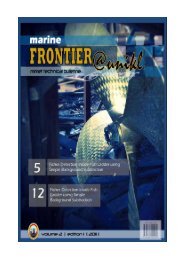click here to download - UniKL MIMET Official Website
click here to download - UniKL MIMET Official Website
click here to download - UniKL MIMET Official Website
You also want an ePaper? Increase the reach of your titles
YUMPU automatically turns print PDFs into web optimized ePapers that Google loves.
As <strong>to</strong> embrittlement, the acidity of water<br />
has been found <strong>to</strong> have great effect on the<br />
speed and the degree <strong>to</strong> which a material can<br />
be dissolved. A metal corrodes because of the<br />
acidity of the solution in which it is immersed<br />
due <strong>to</strong> an interchange of hydrogen ions in the<br />
solution with the a<strong>to</strong>ms of the exposed metal.<br />
When the solution is in liquid form, the metal is<br />
dissolved in<strong>to</strong> the solution and hydrogen tends<br />
<strong>to</strong> plate out on the piece. Once a hydrogen film<br />
has deposited on the exposed surfaces, the dis‐<br />
solving of the metal will cease. Oxygen plays an<br />
important part in this process since the oxygen<br />
that dissolved in water will react with the film<br />
of hydrogen <strong>to</strong> eliminate it by forming water<br />
which allows the corrosion process <strong>to</strong> proceed.<br />
This problem can be solved by coating the<br />
pis<strong>to</strong>ns/cylinders ceramic. It cannot be delayed<br />
as these items will rust, either by sheer use or<br />
by neglect (i.e. letting it sits) and fitted with a<br />
stainless steel exhaust.<br />
Frosting.<br />
Some places such as in Europe are colder<br />
than Malaysia climate. In colder condition, the<br />
water inside the system can be easily getting<br />
frosted and disturb the system. In order <strong>to</strong> solve<br />
this problem, the heating coils <strong>to</strong> prevent water<br />
from freezing in the system.<br />
Hydrogen s<strong>to</strong>rage.<br />
Pure hydrogen is dangerous <strong>to</strong> be s<strong>to</strong>red in<br />
high‐pressure tanks. Like all fuels, hydrogen has<br />
in<strong>here</strong>nt hazards and must be handled care‐<br />
fully. In fact, hydrogen has been used for years<br />
in industrial processes and as a fuel by NASA,<br />
and has earned an excellent safety record. Like<br />
other fuels, hydrogen can be handled and used<br />
safely.<br />
In this case, hydrogen and oxygen were<br />
generated. All hydrogen and oxygen produced<br />
get consumed by the engine instantly. The suit‐<br />
able size of tank for certain pressure is needed<br />
<strong>to</strong> maintain constant flow of supply <strong>to</strong> the en‐<br />
gine. The presence of oxygen and water vapour<br />
<strong>MIMET</strong> Technical Bulletin Volume 1 (2) 2010<br />
in the system makes hydrogen very safe. The<br />
mixture of hydrogen and oxygen give a power‐<br />
ful combustible gas but it is not explosive com‐<br />
pared <strong>to</strong> pure hydrogen. It does not need cool‐<br />
ing and will be ignited only by the strong spark<br />
inside the engine. The hydrogen can be com‐<br />
pressed in<strong>to</strong> a crystal matrix form in order <strong>to</strong><br />
make it safer but it is not so cost‐effective.<br />
Speed control.<br />
In getting the right speed at the right time<br />
and <strong>to</strong> maintain a constant supply, a control<br />
circuit is attached <strong>to</strong> the electrolysis chamber.<br />
This circuit (Figure 5.0) will produce square<br />
pulse signal which 'plays' the stainless steel<br />
electrodes like a tuning fork. The faster speed is<br />
needed, the wider the pulses go in<strong>to</strong> the elec‐<br />
trolysis chamber <strong>to</strong> create more hydrogen gases<br />
as needed. So when the throttle is pushed, it<br />
will electrically create more hydrogen gases for<br />
immediate consumption. On demand, low‐high<br />
flow rate is needed, from idle <strong>to</strong> maximum<br />
power. This signal is the input <strong>to</strong> the circuit as<br />
the primary control (i.e. throttle level = pulse<br />
width = gas rate).<br />
For carburet<strong>to</strong>r, the built‐in vents need <strong>to</strong><br />
be sealed and making a single way air‐intake.<br />
The throttle circuit is set in order <strong>to</strong> maintain<br />
minimum gas flow at idle and maximum gas<br />
flow at full power without blowing the pressure<br />
relief valve. In this way, the mixture is con‐<br />
trolled by the strength of the pulse (i.e. “width”<br />
at the optimum pulse frequency). If t<strong>here</strong> is in‐<br />
sufficient power at any throttle setting, some<br />
variables need <strong>to</strong> be changed such as the pulse<br />
frequency, the gap between the electrodes, the<br />
size (bigger) of the electrodes, or make a higher<br />
output pulse voltage (last resort).<br />
Excess heat.<br />
Excess heat due <strong>to</strong> combustion of hydrogen<br />
and oxygen can be rectified by recent material<br />
achievements and when the hydrogen is burned,<br />
water is produced thus cool down the engine<br />
down via heat transfer.<br />
| MARINE FRONTIER @ <strong>UniKL</strong><br />
22



